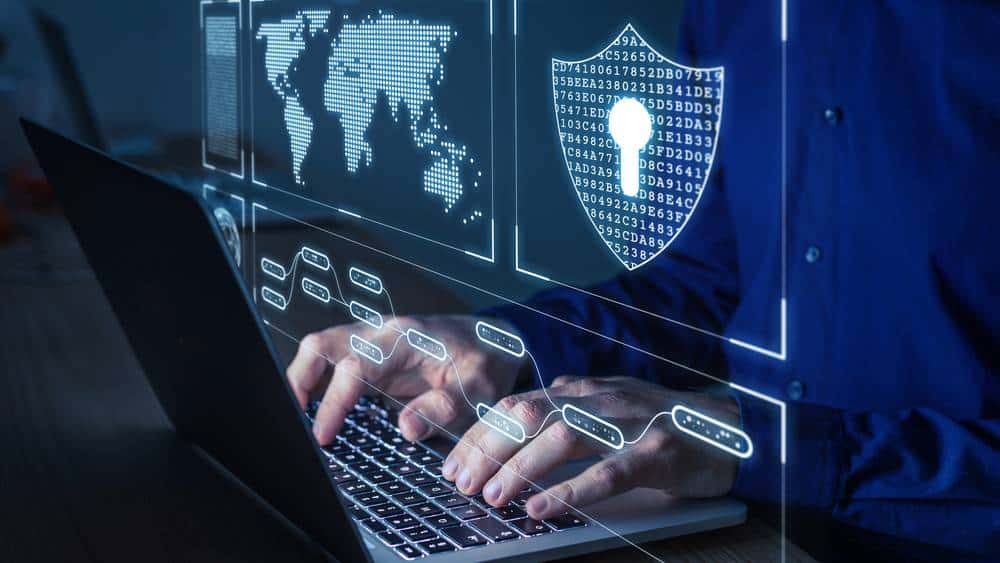Welcome to another educational article on the Cybersecurity Framework.
This article will examine the uses and benefits of Cybersecurity Frameworks.
After perusing this article, you will know the types of Cybersecurity Frameworks and the key elements of a Cybersecurity Framework.
We will discuss the following points:
- Cybersecurity Framework – Overview
- Uses and Benefits of Cybersecurity Frameworks
- Types of Cybersecurity Frameworks
- Key Elements of a Cybersecurity Framework
- Top Cybersecurity Frameworks
So, let’s continue!
Cybersecurity Framework – Overview

Cybersecurity Frameworks are collections of documents that outline principles, standards, and best practices to manage the risks associated with Cybersecurity.
The frameworks are designed to lessen the likelihood of a business being exploited by hackers and other types of cyber criminals by exploiting its weaknesses and vulnerabilities.
Although the phrase “Framework” may give the impression that the term refers to physical components, this is not the case.
In other words, a Cybersecurity Framework is analogous to a “real world” framework.
Benefits of Cybersecurity Frameworks

Frameworks for Cybersecurity take away some of the elements of uncertainty involved in protecting digital assets.
Frameworks provide information security administrators with a dependable, consistent, and systematic method of mitigating cyber risk, regardless of the complexity of the environment.
Frameworks for Cybersecurity provide teams with a planned and well-thought-out plan to safeguard their data, infrastructure, and information systems from potential cyber threats.
These frameworks can assist teams in meeting the difficulties of Cybersecurity.
The guidelines provide direction, assisting IT security directors in managing their organizations’ cyber risks more intelligently.

Companies can either develop their internal framework from scratch or adapt and modify an existing one to better suit their requirements.
However, the second choice may be more difficult for some companies because of the security frameworks they must implement to comply with commercial or regulatory standards.
There is a possibility that home-grown frameworks will not be adequate to achieve those standards.
Ultimately, it is becoming anticipated for firms to adhere to established Cybersecurity standards, and utilizing these frameworks makes compliance easier and more ingenious.
The appropriate framework will cater to the requirements of a wide variety of enterprises of varying sizes, independent of the myriad of various industries that they are a part of.
Frameworks make it easier for businesses to adhere to the appropriate security processes, which helps keep the firm secure and builds customer trust.
Customers are more likely to feel comfortable transacting business online with a company that adheres to well-established security measures and protects the confidentiality of their financial information.
Types of Cybersecurity Frameworks

The required function typically categorizes Cybersecurity Frameworks into one of three distinct categories.
Control Framework
A foundational strategy for the organization’s Cybersecurity department is developed through the control structure.
In addition to evaluating the current condition of the technology and infrastructure, it delivers a standard set of security measures as a starting point.
In addition, it gives the installation of security controls a high priority.
Program Framework
The program framework evaluates an organization’s security program and contributes to developing a comprehensive Cybersecurity Program.
Additionally, it does a competitive analysis and security evaluation of the program, facilitating and simplifying interactions among the Cybersecurity team, managers, and other stakeholders.
Risk Framework
A security program can be structured in a way conducive to risk management thanks to the risk framework, which describes risk assessment and management processes.
Additionally, it detects, measures, and quantifies the many security risks that the company faces.
In addition to this, it emphasizes appropriate safety precautions and activities.
Key Elements of a Cybersecurity Framework

Most businesses build their Cybersecurity strategy on an established framework.
The following are the five elements or functions of the framework:
- Protect
- Identify
- Respond
- Detect
- Recover
Your complete environment, including apps, data, and users, must be included in the framework’s scope.
A complete and all-encompassing framework will include the following components:
- Endpoints
- Networking
- Public, private, and hybrid clouds
- Servers
- Storage
- Data recovery
- Data protection
Building a CSF on an inherent foundation that enables automation, responsiveness, adaptability, intelligence, and maximal protection against threats is important to establish best practices in these areas.
Element 1 – Identify
Evaluating hardware and software assets, evaluating the supply chain, and creating a risk management plan are all included.

Implementing a risk management strategy that incorporates risk tolerances also entails determining security regulations, asset vulnerabilities, and risk management tactics.
Element 2 – Protect
It ensures identity and access management protection through employee awareness and training.
It establishes data security coherent with risk strategy and implements protection procedures.
It protects corporate resources through maintenance and managing barrier protection technology to guarantee the integrity and adaptability of critical infrastructure.
Element 3 – Detect
It outlines the necessary steps to recognize a Cybersecurity event and facilitate quick discovery.
These activities include making sure that aberrations and incidents are identified; establishing continuous monitoring capabilities.
It ensures that detection systems are kept up to date so that unusual occurrences are brought to the user’s attention.
Element 4 – Respond
It provides support for the capability to lessen the effects of a possible Cybersecurity event.
This support entails ensuring that response planning is carried out, managing communications, analyzing to ensure adequate recovery and response actions, including forensic analysis, and carrying out mitigation activities.
Element 5 – Recover
It identifies the activities for maintaining resilience plans and resuming any services.
The organization must follow recovery planning procedures to restore systems or assets that Cybersecurity incidents have impacted.
Adjustments and controlling information flow from a cyber incident to recovery are additional tasks.
Top Cybersecurity Frameworks

When selecting a framework for your Cybersecurity, you have a wide variety of options available to you.
Naturally, the requirements for security at your firm should guide your decision.
When looking for direction, businesses consult Cybersecurity Frameworks.
IT security teams can intelligently manage the cyber dangers faced by their companies if they have the necessary framework and it is implemented correctly.
Businesses can either customize an existing framework or develop their in-house solution.
Enterprises must implement information security frameworks to comply with government or industry laws.
For instance, if your company processes credit card transactions, it must adhere to the guidelines of the PCI-DSS framework.
In this particular scenario, your business needs to demonstrate that it has successfully passed an audit that tests for compliance with the PCI-DSS framework criteria.
NIST Framework
In response to Presidential Executive Order 13636, the National Institute of Standards and Technology (NIST) developed the “NIST Cybersecurity Framework.”
The NIST was established to prevent cyberattacks against the vital American infrastructure, including dams and power plants.
The framework consists of a set of voluntary security standards that businesses operating in the private sector can use to locate, recognize, and respond to cyberattacks.
The framework also includes a set of rules designed to assist enterprises in avoiding cyberattacks and recovering from those attacks.
CIS Framework
You may want to go with CIS if you want your organization to begin on a modest scale and then steadily increase in size over time.
The latter part of the 2000s saw the development of this framework, which was intended to safeguard businesses from various forms of cyberattacks.
It comprises twenty controls that are kept up to date consistently by security professionals from various industries.
The basics are the first step in the framework, then it carries on to the foundational level and concludes with the organizational level.
The framework developed by the Center for Internet Security uses benchmarks mapped to security standards and offers alternative configurations for organizations that are not required to adhere to mandatory security protocols but still want to improve their Cybersecurity.
These benchmarks are based on common standards such as those developed by NIST.
ISO Framework
This structure is also known by the name ISO 270K.
The Cybersecurity validation standard is believed to have the highest level of worldwide recognition for use in both internal scenarios and third parties.
The implementation of ISO 270K is based on the presumption that the organization already possesses an Information Security Management System.
Management must exhaustively manage their organization’s information security risks, emphasizing dangers and openings.
The framework suggests 114 distinct controls, sorted into 14 separate groups.
Consequently, ISO 270K might not be suitable for everyone, given the effort required to keep the standards up to date.
However, if applying ISO 270K is a selling feature that will bring in new clients, it is worth investing in.
HIPAA Framework
The 1996 Health Insurance Portability and Accountability Act, more commonly referred to as HIPAA, is a law that establishes a framework for managing personal patient and consumer data.

This legislation is vital for Healthcare providers, clearing houses, and insurers as it safeguards electronic Healthcare information and ensures its confidentiality.
Conclusion

Various Cybersecurity requirements must be complied with by the vast majority of firms, particularly those that operate internationally.
Using frameworks is a potentially useful strategy for overcoming this challenging obstacle.
They enable you to develop, enforce, and monitor controls across numerous compliance regimens in a unified manner.
Frameworks for Cybersecurity give a foundation for obtaining a high level of security and preventing data breaches.
Adopting a framework necessitates the commitment of both time and resources to the whole endeavor.
However, if done correctly, it is well worth the effort.
FAQs

Is NIST the best Cybersecurity Framework?
It is widely acknowledged as the finest practice in the industry, with the most extensive, thorough, and comprehensive controls of any Framework.
The NIST Framework is essential for protecting an organization from potential cyber-attacks, which is the top objective of any Cybersecurity leader or practitioner.
Why is the Cybersecurity Framework Important?
Cybersecurity Frameworks are collections of documents that outline principles, standards, and best practices to manage the risks associated with Cybersecurity.
The Frameworks are designed to lessen the likelihood of a business being exploited by hackers and other types of cyber criminals by exploiting its weaknesses and vulnerabilities.
What is the difference between ISO and NIST?
Even though it is a process for self-certification, NIST is widely acknowledged.
ISO 27001 provides 14 control categories with 114 controls and has 10 management clauses to guide organizations through their information security management systems.
NIST frameworks have a variety of control catalogs and five functions to customize cybersecurity controls.
Why is the NIST Framework important?
The National Institute of Standards and Technology aims to assist commercial enterprises and other organizations in protecting private information but not classified.
In addition, protecting critical infrastructure and information from insider threats and general human irresponsibility is one benefit of applying the NIST-recommended best practices.
What is ISO 27001?
The Standard provides a set of controls that are considered to be industry best practices.
You can apply these controls to your organization based on the risks exposed, and they can be implemented in a structured manner to achieve compliance that is externally assessed and certified.









